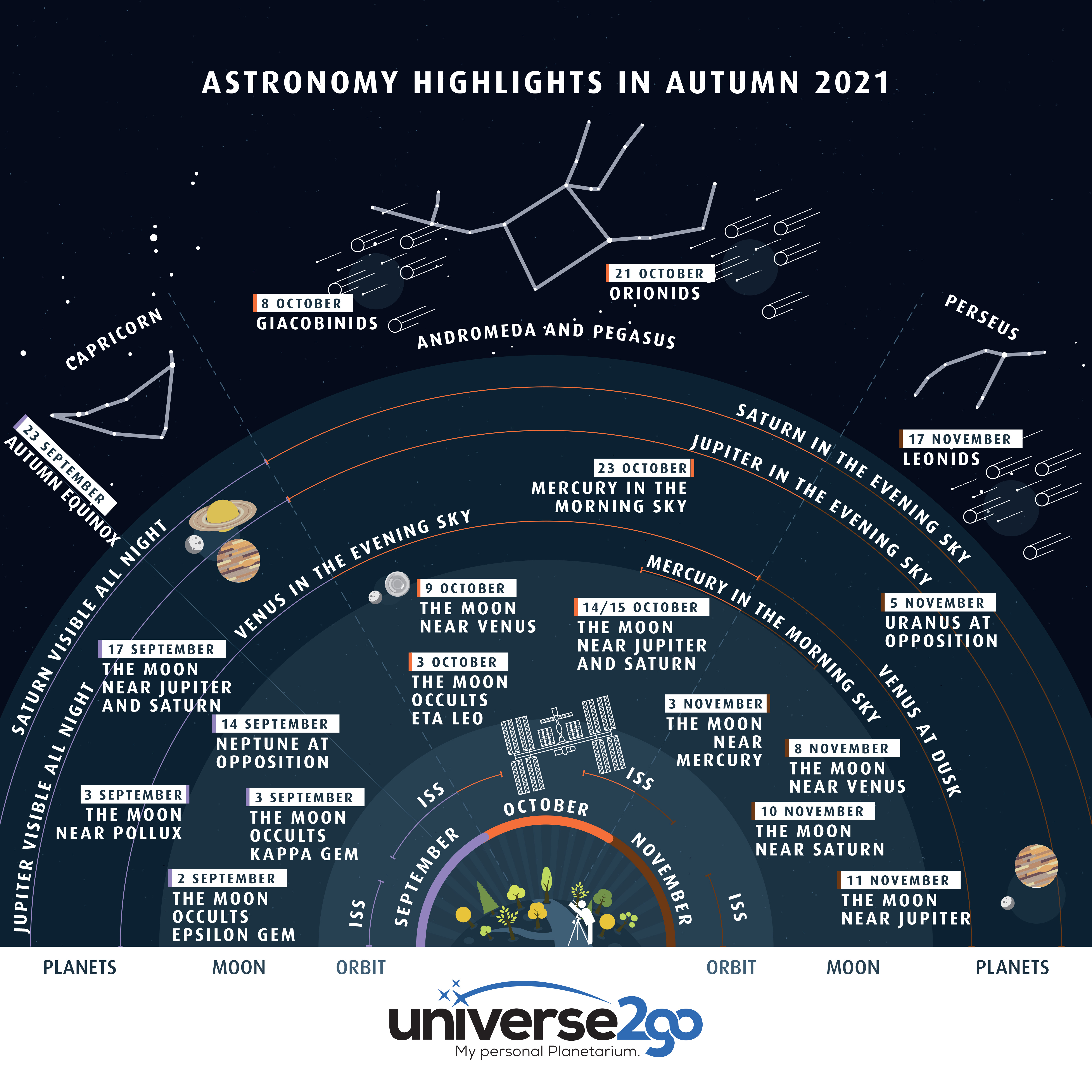Autumn has a planetary focus on Jupiter and Saturn which are both still brilliantly visible. Additionally, you have the chance to see the two outermost planets, Uranus and Neptune, at opposition.
In the “Astronomy Highlights in Autumn 2021” infographic, you can find numerous important celestial events at a glance. You can find dates and detailed descriptions of the events in the accompanying text.
Have fun observing!

September
September occurs in the period between summer and autumn. This can also be seen in the night skies. The constellations Hercules and Lyra drift westward. Contrastingly, the constellation Capricorn is conspicuous alongside the large planets Jupiter and Saturn in the south.
02/09 The Moon occults Epsilon Gem – In the early hours of the morning, the slender crescent moon occults the star Epsilon Gem in the constellation Gemini. The Moon approaches with its illuminated side at around 2am. You need a very good view of the horizon facing towards the north-east. (Visibility depends on observer location)
03/09 The Moon occults Epsilon Gem – At 4:38am, the slender crescent moon occults the star Kappa Gem in the constellation Gemini. An attractive occultation as the Moon appears as a narrow crescent. (Visibility depends on observer location)
3.9. Conjunction between the Moon and Pollux – In the second half of the night, the Moon appears over the horizon in the constellation Gemini. Only 3 degrees separate it from Pollux.
14.9. Neptune at opposition – The solar system’s furthest planet is at opposition and looks magnificent. You can see it as a star by using binoculars but it is only by using a telescope that you can see the 2.3 arc second planet as a small sliver. A star chart or an app would benefit you here.
17.9. Conjunction between Jupiter and Saturn – Both large planets meet in the constellation Capricorn. With the Moon in the middle, they form a triangle.
October
October definitively marks the start of autumn. High above our heads we can see the famous Great Square of Pegasus and the constellation Andromeda. Time to take an extensive trip to the Andromeda Galaxy. Always an experience with binoculars.
03/10 The Moon occults Eta Leo – In the early hours of the morning, at around 5:27am, it is still dark. It is now that the Moon occults the 3.4 mag star Eta Leo with its narrow-illuminated side. It is definitely the most impressive star occultation of the quarter. (Visibility depends on observer location)
08/10 Giacobinids – The Giacobinids or Draconids are a meteor shower which appears to stem from the constellation Draco. The maximum fall rates can be expected on 8 October. Unfortunately, the expected number cannot be predicted as it can vary considerably. The radiant is located near the star Beta Draconis. Draco is part of a circumpolar constellation which is why the radiant is at its optimal visible altitude in the evening.
09/10 Conjunction between the Moon and Venus – At sunset, a brilliant Venus and a 3.5-day-young crescent moon rise in the southwest. There is a maximum time window of 2 hours until Venus disappears below the horizon.
14-15/10 Conjunction between the Moon, Jupiter and Saturn – At the end of the civil twilight, at around 19:00, the planets Jupiter and Saturn rise dominantly in the sky. Although they were at opposition in August, they are still a rewarding target. The Moon does not disrupt their observation.
21/10 Orionids – The Orionids are a smaller meteor shower with around 20 meteors per hour. The radiant is located in the constellation Orion, near the star Betelgeuse. Although you can observe the meteor shower all month, it peaks between October 20 and 21. The best time for observing is between 22:00 and 05:00.
23/10 Mercury in the morning sky – In May, Mercury could be seen in the evening sky whereas now the planet is offering us a short period of morning visibility. Between 23/10 and 31/10, you can see it just above the eastern horizon.
November
The constellation Perseus is near the zenith in November. This is where you will find the two brightest stars, Mirfak and Algol. The famous binary star cluster h + chi illuminates the space between Perseus and Cassiopeia and can be seen with the naked eye in dark areas.
03/11 Conjunction between the Moon and Mercury – There are two reasons to get up early today. This morning, the delicate crescent moon and Mercury are in conjunction. One of the last opportunities before Mercury disappears into the Sun’s glare.
05/11 Uranus at opposition – At mag. 5.6, Uranus is currently visible with the naked eye. However, it is easier to spot using binoculars or a telescope. This makes it appear as a tiny green disc with no recognisable details. However, it can still be identified as a planet.
08/11 Conjunction between the Moon and Venus – The waxing crescent moon is in conjunction with the twinkling brightness of Venus.
10/11 Conjunction between the Moon and Saturn – The Moon passes Saturn only 4.5 degrees beneath it.
11/11 Conjunction between the Moon and Jupiter – Tonight the Moon passes Jupiter, moving at almost one degree per hour. We can track the movement relative to Jupiter quite well.
17/11 Leonids – The Leonids reach their peak from November 16 to 17. Along with the Perseids, they are one of the most famous meteor showers. There have been years in which these meteors have fallen like raindrops from the sky. This generally takes place every 33 years when the Earth runs into the Leonid cloud. In normal years, the shower does not exceed 20 meteors per hour at its peak. This year, the slender crescent moon sets early on and we can enjoy the meteors all night long without interruption.



